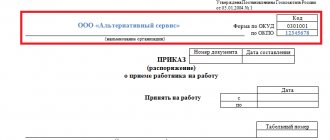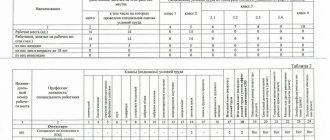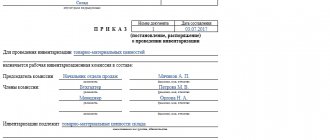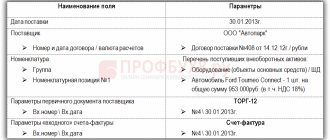Order on commissioning of fixed assets sample
A selection of the most important documents upon request Order on commissioning of fixed assets sample
(regulatory legal acts, forms, articles, expert consultations and much more).
Articles, comments, answers to questions: Order on commissioning of fixed assets sample
The document is available: in the commercial version of ConsultantPlus
The document is available: in the commercial version of ConsultantPlus
Document forms: Order on commissioning of fixed assets sample
The document is available: in the commercial version of ConsultantPlus
The document is available: in the commercial version of ConsultantPlus
for free
.
Order on commissioning of a fixed asset facility. In this case, such official papers as construction permits, urban planning plans for land plots, and a package of project documentation must also be available.
We recommend reading: If you are insulted, can you go to court?
What is the purpose of the operational act? How is the selection of the inspection commission carried out? Letter of the Federal Tax Service of the Russian Federation dated July 25, 2021 No. ED-4-15/
“On the work of the commission on the legalization of the tax base and the base for insurance premiums”
activities to control the payment of “shadow” wages were regulated.
A municipal budgetary institution acquires fixed assets - computer equipment
.
At the same time, the Federal Tax Service departments in the constituent entities of the Russian Federation were instructed to bring this letter to lower tax authorities and ensure its application. From this article you will learn, in particular, how candidates are selected for invitation to a meeting of such a commission and what to do when you receive an information letter from the inspectorate and a notice of invitation to the taxpayer.
On the basis of what primary accounting documents can these fixed assets be accepted for accounting? Having considered the issue, we came to the following conclusion: According to clause 9 of the Instruction, approved by Order of the Ministry of Finance of Russia dated December 1, 2010 N 157n (hereinafter referred to as Instruction N 157n), in order to ensure timely and reliable reflection in the accounting of business transactions (results of operations), the institution must form the primary accounting document at the time of a business transaction, and if this is not possible, immediately after the completion of the transaction.
In accordance with paragraph 34 of Instruction No. 157n, the acceptance of fixed assets for accounting, as well as their disposal, is carried out on the basis of a decision of the permanent commission for the receipt and disposal of assets, drawn up by a supporting document (primary (consolidated) accounting document) - an Act in the form established regulatory legal acts adopted in accordance with the legislation of the Russian Federation by the Ministry of Finance of the Russian Federation.
Approximate form of an order for commissioning of a fixed asset (prepared by experts)
Order on commissioning of a fixed asset
[ day month Year ]
N [enter as required]
In connection with the acquisition by an organization (enterprise) of [insert the name of a fixed asset], in accordance with Resolution of the State Statistics Committee of the Russian Federation dated January 21, 2003 No. 7 “On approval of unified forms of primary documentation for accounting of fixed assets,” I order:
1. Put the fixed asset [name] into operation on [day, month, year].
2. Accept [name of fixed asset] for accounting as part of fixed assets with an initial cost of [specify amount].
3. Determine the useful life of [name of fixed asset] during [enter as required].
4. Assign an inventory number to the fixed asset [enter the required one].
5. Appoint [position, full name] as the financially responsible person for the fixed asset.
6. Entrust control over the execution of the order to [position] [full name. ].
[job title] [signature] [F. AND ABOUT. ]
I have read the order:
[job title] [signature] [F. AND ABOUT. ]
The current version of the document you are interested in is available only in the commercial version of the GARANT system. You can purchase a document for 54 rubles or get full access to the GARANT system free of charge for 3 days.
If you are a user of the Internet version of the GARANT system, you can open this document right now or request it via the Hotline in the system.
Sample form of an order for commissioning of a fixed asset
Developed: March 2009
Results
The procedure for capitalizing OS takes place in several stages:
- receipt of OS by the company;
- work of the commission to determine the state of the OS and the need for improvement;
- collection of costs for bringing the OS to a state suitable for use on account 08;
- putting the OS into operation and transferring the cost of the OS to account 01;
- determining the useful life and depreciation method.
At the same time, at each stage, primary documents should be drawn up using independently developed or unified forms (depending on the accounting policy).
You can find more complete information on the topic in ConsultantPlus. Free trial access to the system for 2 days.
Write-off of fixed assets: sample orders
The registration, movement and disposal of fixed assets is regulated in accounting PBU 6/01 “Accounting for fixed assets” (Order of the Ministry of Finance 26n dated 30.03.01) and Guidelines for accounting of fixed assets (Fixed Assets) (Order of the Ministry of Finance 91n dated 13.10.03 ).
The value of property is written off when it is disposed of or is unable to generate economic benefits in the future. An object may be disposed of in the following cases:
- sales;
- donations;
- termination of use due to moral or physical wear and tear;
- emergency response;
- identifying shortages during inventory;
- transfers in the form of a contribution to the authorized capital of another company;
- in other cases.
In order to establish the safety of property, organizations conduct an inventory. The procedure for its implementation is regulated by the Methodological Instructions approved by Order of the Ministry of Finance No. 49 of June 13, 1995.
Inventory is also necessary to identify fixed assets that are unsuitable for use, or whose further use in the company’s activities is impractical. A sample order for an inventory of fixed assets can be downloaded at the end of the article.
Conducting an inspection can be mandatory and proactive. Inventory is required in the following cases (clause 1.5 of the Guidelines):
- preparation of annual reports (an inventory of fixed assets is allowed once every three years);
- change of financially responsible person;
- identification of facts of damage and theft of property;
- natural Disasters.
To carry out the inventory, the company's management appoints a commission. It is advisable to include representatives of the administration, employees of engineering and technical services, and financial employees. The inspection is carried out in the presence of the person responsible for the safety of the property.
If obsolete or damaged equipment is identified, the commission may decide to repair, restore the OS, or liquidate it.
Sample order for inventory of fixed assets
Procedure for accepting fixed assets for accounting
OS can be supplied to a company in different ways:
- purchase;
- receiving as a gift;
- exchange;
- production in-house or under a contract;
- identification of surpluses during inventory;
- receipts under a leasing agreement;
- contribution as a contribution to the authorized capital.
The main regulatory legal act regulating the accounting of fixed assets is PBU 6/01 (Order of the Ministry of Finance dated March 30, 2001 No. 26n). According to clause 4 of this PBU, in order to capitalize an asset as fixed assets, a number of conditions must be met:
- the asset will be used in the production of products or provision of services, for rental or leasing, as well as for the needs of management personnel;
- it will be used for more than 12 months;
- the company does not intend to resell the asset;
- it will bring income.
For accounting purposes, it is recommended to classify assets as fixed assets when their value is more than 40,000 rubles. (clause 5 of PBU 6/01). For tax purposes, the threshold for accepting depreciable property for accounting is 100,000 rubles. (Clause 1 of Article 256 of the Tax Code of the Russian Federation).
To learn how to eliminate the difference between accounting and tax accounting, read the article “A way to take into account fixed assets worth from 40 to 100 thousand rubles in tax accounting, avoiding differences with accounting.”
For an example of registering a car as an OS object, see ConsultantPlus. If you do not have access to the K+ system, get a trial online access for free.
The asset accounting unit is an inventory object. When accepting an asset, a commission is created that determines the compliance of the OS with technical documentation and the intended conditions of use, and also decides on the need to bring the OS to a state suitable for use (Resolution of the State Statistics Committee of the Russian Federation dated January 21, 2003 No. 7).
Fixed assets are accepted for accounting at historical cost - the procedure for its formation depends on the method of receipt of the asset to the company:
- for the purchase of fixed assets - the cost of the asset itself;
- for a contribution to the management company - the monetary value agreed upon by the founders;
- when donated and identified during inventory - the market value on the date the asset was accepted for accounting;
- in the case of an exchange, the value of the objects transferred in exchange.
In all cases, in addition to the indicated expenses, the initial cost includes actual expenses for delivery, installation of OS, intermediary and consulting services (clause 8 of PBU 6/01).
VAT and other refundable taxes are not included in the cost of fixed assets - read more about this in the article “How to claim VAT on fixed assets or equipment for deduction?”
Repair, modernization and reconstruction
In order for the OS to be used for a long period, it must be repaired. During repairs, the characteristics of the object are not improved, but only its viability is maintained. Repair costs are considered expenses of the current period in both accounting and tax accounting (clause 1 of Article 260 of the Tax Code of the Russian Federation).
Modernization or reconstruction of equipment is carried out in order to improve its performance, power, increase its useful life or change its purpose. The costs of such work are taken into account as capital investments and increase the cost of the facility being modernized (clause 27 of PBU 6/01, clause 2 of Article 257 of the Tax Code of the Russian Federation).
Depreciation on reconstructed or modernized equipment continues to accrue throughout the entire period of work. But if modernization and reconstruction work continues for more than 12 months, then depreciation should be stopped until the work is completed (clause 2 of Article 322 of the Tax Code of the Russian Federation).
Sample order for modernization of fixed assets
During downtime, the OS can be put into storage. This procedure includes a set of measures to preserve the integrity and serviceability of the property until it begins to be used in business again.
The procedure for conservation of objects is developed and approved by the organization independently. It should be borne in mind that the transfer of idle equipment to mothballing is not the responsibility of the company; such a decision is made by the company’s management.
See also: Employment contract not registered
The costs of conservation and removal of equipment from it are included in the enterprise’s expenses in the current period. When transferring to conservation, you should keep in mind that the property will not be exempt from property tax for this period. But the calculation of depreciation should be suspended when the object is mothballed for a period of more than three months (clause 2 of Article 322 of the Tax Code of the Russian Federation).
Sample order on conservation of fixed assets
To determine the possibility of further use of the property, by decision of the company management, a commission is created, which includes persons responsible for the safety of the property, technical specialists, financial workers (clause 77 of Order of the Ministry of Finance 91n dated 10/13/03).
The commission is entrusted with the responsibility of inspecting the facility, making a decision on its liquidation, identifying the reasons for the impossibility of further operation and the persons responsible for this, as well as drawing up a decommissioning act. The write-off act can be developed by the organization independently, or one of the unified forms can be used: OS-4, OS-4a, OS-4b (Resolution of the State Statistics Committee of the Russian Federation 7 of 01.21.03). Based on the act, the object is written off from the register and a mark of disposal is placed on its inventory card.
The residual value of the written-off object is reflected in non-operating expenses in both accounting and tax accounting on the date of the write-off act. Also, non-operating expenses should reflect the costs of dismantling, removal and other actions related to the liquidation of the facility.
The components of the liquidated object, suitable for further use, are accounted for at the current market value, reflected in non-operating income.
No special order required
Is it necessary to issue an order to put a fixed asset into operation (and what form) if its cost is written off as expenses when accepted for accounting?
The procedure for accounting for fixed assets, putting them into operation and writing off their value as expenses of the organization must be reflected in the accounting policy and approved by the head of the organization (clause 5 of PBU 1/98 “accounting policy of the organization”).
When developing an organization's accounting policy, the choice of method for assessing assets and calculating depreciation is carried out from those options that are provided for by current legislation.
As a general rule, the cost of fixed assets is repaid both in accounting and tax accounting through depreciation (clause 17 PBU 6/01 “Accounting for fixed assets”, clause 1 of Article 256 of the Tax Code of the Russian Federation).
Currently, accounting rules stipulate that assets in respect of which the conditions provided for fixed assets are met (clause 4 of PBU 6/01), and with a value within the limit established in the organization’s accounting policies, but not more than 20,000 rubles. per unit, can be reflected in the organization’s accounting records as inventories (clause 5 of PBU 6/01). FOR YOUR INFORMATION!
Until January 1, 2006, fixed assets worth no more than 10,000 rubles were included in accounting records. it was allowed to be written off as expenses as they were released into production or operation (clause 18 of the old edition of PBU 6/01). From January 1, 2006, the procedure for accounting for fixed assets has changed (see order of the Ministry of Finance of Russia dated December 2, 2005 N 147n “On amendments to PBU 6/01”).
If the organization decides to account for such objects as part of the inventory (and reflects this in the accounting policy), then accounting for such assets and writing off their value as expenses should be carried out according to the rules of PBU 5/01 “Accounting for inventories” in accordance with the Methodological Guidelines for Accounting for Inventory (approved by Order of the Ministry of Finance of Russia dated December 28, 2001 N 119n).
For such objects, appropriate accounting cards must be maintained (receipt order in Form N M-4, demand invoice in Form N M-11, material accounting card in Form N M-17, etc.) (see letter from the Ministry of Finance of Russia dated May 30. 2006 N 03-03-04/4/98).
If the organization accounts for assets worth up to 20,000 rubles, which are discussed in paragraph 5 of PBU 6/01, as part of fixed assets (which is reflected in the accounting accounts), then transactions on fixed assets must be documented as follows:
- acceptance of a fixed asset object for accounting is formalized by a transfer and acceptance certificate in Form N OS-1 (OS-1a, OS-1b);
- Inventory cards are created for fixed assets in Form N OS-6;
- fixed assets are assigned inventory numbers, etc.
Form N OS-1 (approved by Order of the State Statistics Committee of Russia dated January 21, 2003 N 7) stipulates that the basis for drawing up an acceptance certificate for an object of fixed assets is an order, instruction or agreement. At the same time, the norms of Russian legislation do not stipulate that the commissioning of a fixed asset object must be formalized by a separate order or form. Information about the date of commissioning of a fixed asset object is reflected in Form N OS-1. From this we can conclude that there is no need to issue a separate order to put a fixed asset into operation.
Note! The cost of a fixed asset (as noted above) is written off as an organization's expenses through depreciation, and not when the object is accepted for accounting.







